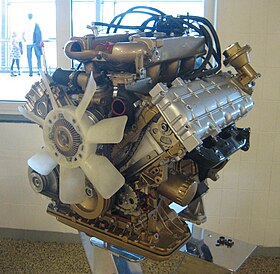
Back V6 PRV-motor Danish PRV-Motor German Motor V6 PRV Spanish Moteur V6 PRV French Motore V6 PRV Italian PRVエンジン Japanese V6 PRV-motor Dutch PRV-motor NB Motor PRV Portuguese Двигатель PRV Russian
| PRV engine | |
|---|---|
 | |
| Overview | |
| Manufacturer | Française de Mécanique |
| Production | 1974–1998 |
| Layout | |
| Configuration | 90° V6 |
| Displacement | 2,458 cc (2.5 L; 150.0 cu in) 2,664 cc (2.7 L; 162.6 cu in) 2,849 cc (2.8 L; 173.9 cu in) 2,963 cc (3.0 L; 180.8 cu in) 2,975 cc (3.0 L; 181.5 cu in) |
| Cylinder bore | 88 mm (3.46 in) 91 mm (3.58 in) 93 mm (3.66 in) |
| Piston stroke | 63 mm (2.48 in) 72.7 mm (2.86 in) 73 mm (2.87 in) |
| Cylinder block material | Aluminium |
| Cylinder head material | Aluminium |
| Valvetrain | SOHC 2 or 4 valves per cyl DOHC 4 valves per cyl (race engine) |
| Combustion | |
| Turbocharger | Various versions |
| Fuel system | Carburetor Fuel injection |
| Fuel type | Gasoline |
| Oil system | Wet sump |
| Cooling system | Water-cooled |
| Output | |
| Power output | 97–300 kW (132–408 PS; 130–402 bhp) |
| Torque output | 208–520 N⋅m (153–384 lbf⋅ft) |
| Chronology | |
| Successor | V6 ESL engine Volvo Modular engine |
The V6 PRV engine is an overhead cam V6 automobile engine designed and manufactured by the company "Française de Mécanique" for PRV, an alliance of Peugeot, Renault and Volvo Cars. Sold from 1974 to 1998, it was produced in four displacements between 2.5 L and 3.0, and in both SOHC and DOHC and 2-valve and 4-valve per cylinder configurations. Originally carbureted, it adopted fuel-injection for improved emissions compliance and improved performance, and was offered in turbo and biturbo versions in a limited number of vehicles made by Renault, Chrysler Motors, and French supercar manufacturer Venturi.
It was gradually replaced after 1994 by another engine jointly developed by Peugeot-successor PSA and Renault, known as the ES engine at PSA and the L engine at Renault.